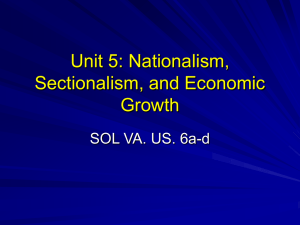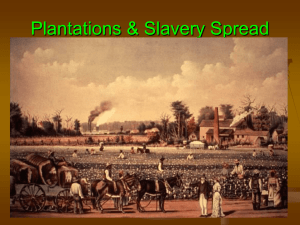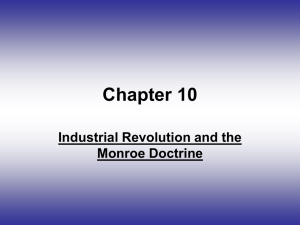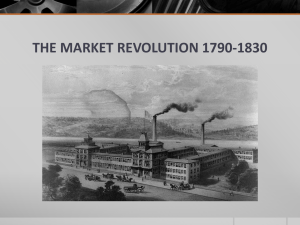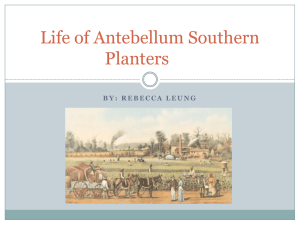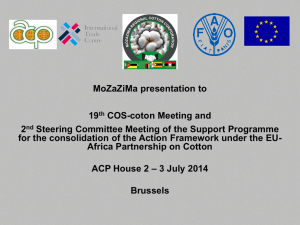Sectionalism and Nationalism
advertisement
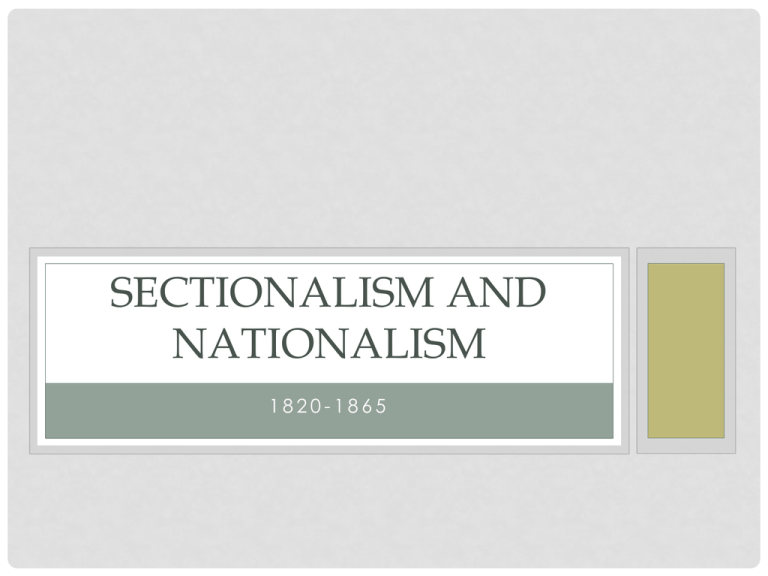
SECTIONALISM AND NATIONALISM 1820-1865 • I can describe how different sections of the nation developed different patterns of life and ideas on government. • I can determine how changes in transportation and industry affected life. • I can evaluate sources of unity and nationalism. • I can describe the outcomes of Supreme Court cases at this time that strengthened the federal government. SECTIONALISM – STRONG SENSE OF LOYALTY TO A SECTION OR REGION INSTEAD OF THE NATION AS A WHOLE • NORTH • Industrial Revolution – shift in Northeast to manufacturing instead of just shipping and trade • Agriculture and slavery dwindling in north • Factory system – machinery and laborers assigned to different tasks, new approach taking industry out of homes and small workshops • Where? – starts in GB, comes to NE • When? – late 1700s, early 1800s • Mass production – production of goods in large quantities • Textile industry – starts to demand cotton from south • SOUTH • King cotton – in demand in Britain and north, Louisiana, Miss, Alabama become cotton kingdoms • Slavery – declined during the Revolution but on the rise in 1820s, greatly leaps from 1820-1860 paralleling growth in cotton production • Cotton gin – Eli Whitney machine helped comb the cotton of seeds, wealthier farmers bought up large areas of land between Appalachian Mts. And Miss. setting up large plantations NATIONALISM – “ERA OF GOOD FEELINGS” • American System – 1815 under Madison, promoted by Henry Clay • Transportation and other internal improvements • Established protective tariff (tax on imported manufactured goods) • Resurrecting national bank • Second Bank of US – made nationwide currency, helped business • Tariff of 1816 – increased price on Brit. Goods allowing Am. Made merchandise and even field to compete • Transportation Revolution and Internal Improvements – needed for people in different regions to do business, travel, communicate and transport goods • National Road – connected Maryland to Illinois 1838 • Erie Canal – 1825 linked Hudson River to Lake Erie (Atlantic O – Great Lakes) http://www.history.com/topics/usstates/new-york/videos/building-the-erie-canal • NYC – dominant port SUPREME COURT UNDER CHIEF JUSTICE JOHN MARSHALL (MARBURY V. MADISON TOO) • Federalist believing in strengthening federal government, defined and strengthened power of Supreme Court and judicial branch • McCulloch v. Maryland – strengthened fed. Government’s control over the economy, state could not tax a federal bank • Gibbons v. Ogden – fed gov has the power to regulate everything that crosses state lines (today includes shipping by truck, train, plane, air traffic, tv, cell phone transmissions) • Limiting state powers – states could not interfere with business and commerce and interfere with contracts • Foreign Policy – priority was security and expansion of territory, Rush-Bagot Treaty 1817 led to demilitarized border with Canada • Adams-Onis Treaty – Spain gave up Florida and claims in Oregon • Monroe Doctrine – warned Europe not to interfere in Western hemisphere with existing colonies and US would stay out of Euro affairs 1820 1850 • • • • • • • • • • • 1. The main purpose of the Monroe Doctrine (1823) was to (1) stake a claim to Mexican territory (2) limit European influence in the Americas (3) force the British out of the Oregon Territory (4) establish full control over Canada 2. During the first half of the 19th century, the construction of canals and roads led to the (1) expansion of trade between Midwestern farmers and eastern merchants (2) growth of plantation agriculture in Texas and New Mexico (3) severe economic decline of the South (4) bankruptcy of several railroad companies in the Mississippi Valley 3. A high protective tariff passed by Congress is intended to affect the United States economy by • (1) promoting free trade • (2) limiting industrial jobs • (3) encouraging American manufacturing • (4) expanding global interdependence 4. The climate and topography of the southeastern United States had a major impact on the history of the United States before 1860 because the region • (1) became the center of commerce and manufacturing • (2) developed as the largest domestic source of steel production • (3) was the area in which most immigrants chose to settle • (4) provided agricultural products that were processed in the North and in Europe • 5. What was an immediate effect of the completion of the Erie Canal in 1825? • (1) Prices increased for food products along the Atlantic Coast. • (2) Farmers could more easily ship grain to eastern markets. • (3) A territorial conflict began with Canada over the Great Lakes. • (4) Railroads were forced to reduce their shipping rates. • 6. What was one result of the Supreme Court’s decision in Gibbons v. Ogden (1824)? • (1) The power of the federal government over interstate commerce was strengthened. • (2) The rights of accused individuals were expanded. • (3) The power of the judicial branch was limited. • (4) The Court declined to hear cases involving disputes between states. • 7. Many of the decisions made by the Supreme Court while John Marshall was Chief Justice led directly to • (1) a reduction of federal influence in economic affairs • (2) an increase in the power of the federal government over the states • (3) a greater role for Congress in foreign policy • (4) a limitation on slavery in the states • 8. During the first part of the 19th century, differences between the North, South, and West led to • (1) sectionalism (2) isolationism • (3) federalism (4) mercantilism • 9. The cotton gin advanced the growth of the textile industry because it • (1) reduced the time needed to plant cotton seeds • (2) improved the process of weaving cotton cloth • (3) made it possible for unskilled slaves to cultivate cotton • (4) provided a faster method of separating seeds from cotton fiber •

